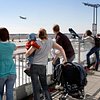
Frankfurt Airport (FRA) is Germany's busiest airport. It is also one of Europe's busiest with flights to all major European cities and all major global destinations. The airport is an efficient, modern, amenity packed transportation hub with easy access via outstanding roadways and extensive rail connections.
History
Frankfurt Airport opened in 1936 as a small airfield near the banks of the Main River southwest of the center of Frankfurt am Main. Rhein-Main Airport was the official name. The airfield served as a facility for airline and large airship operations. The notable airships that claimed Rhein-Main as home base were the Graf Zeppelin and the Hindenburg. The two airships provided transatlantic service between Germany and New York until the unfortunate Hindenburg incident in May 1937. During the World War II years the airfield was destroyed. After the war ended, the United States established the Rhein-Main Air Force Airbase and rebuilt the facilities. Passenger service resumed in 1951. The U. S. Air Force base closed at the end of 2005 and passenger operations became the primary focus.
Terminals and Airlines

Frankfurt Airport currently has two terminals. Terminal 1 opened in 1972 as a modern replacement to the one that was built in 1962. The terminal has been expanded several times to accommodate increased passenger traffic. Currently, the terminal has 102 gates in four concourses (A, B, C, and Z) and serves approximately 50 million passengers annually. Lufthansa and other airlines in the Star Alliance are based at this terminal. Terminal 2 opened in 1994. The terminal currently has 42 gates in two concourses (D and E) and serves approximately 15 million passengers annually. American, Delta, and other Oneworld and SkyTeam alliance airlines are based at this terminal. A monorail system named SkyLine transports passengers between the terminals. Adjacent rail stations link the airport to Deutsch Bahn providing service to cities throughout Germany and the S-Bahn providing metro service to Frankfurt.

Terminal Amenities
Amenities that make the passenger experience pleasant are plentiful. Both terminals have a whole mélange of restaurants and shops. Food choices include offerings as simple as coffee cafes to sophisticated full service gourmet meals. Retail choices include simple newsstands, duty free shops, gift shops, and ultra-luxury boutiques. The airport even has its own rewards program named Frankfurt Airport Rewards. Points, which may be redeemed for items, are collected through in-person and online purchases from participating airport vendors. Other amenities include free Wi-Fi, movie theatres, Gaming World (a games arcade), yoga rooms, leisure rooms, silent chairs, children’s playrooms, baby rooms, outdoor viewing terraces, and personal tours of the airport. Personal tours, which may be booked online, are available to see the airport’s fire department, hangars, Airbus A380 aircraft, overall operations, and even one that views the operations at sunset.

Future
Frankfurt Airport has big plans for the future. Expansion of existing terminal amenities, taxiways, and a whole new terminal are in the works. Terminal 3 is currently in the construction phase and, when opened, will be one of the world’s most technologically advanced passenger facility. The main goal is to provide ease of transit for the passenger from check-in to boarding. The terminal will initially have 24 gates, handle approximately 14 million passengers annually, and have the ability to double in size when expansion is needed. Operations at the new terminal are projected to begin in 2023.
Frankfurt Airport is a well-run transportation machine. It is large. It is modern. It is technologically advanced. It is German.










